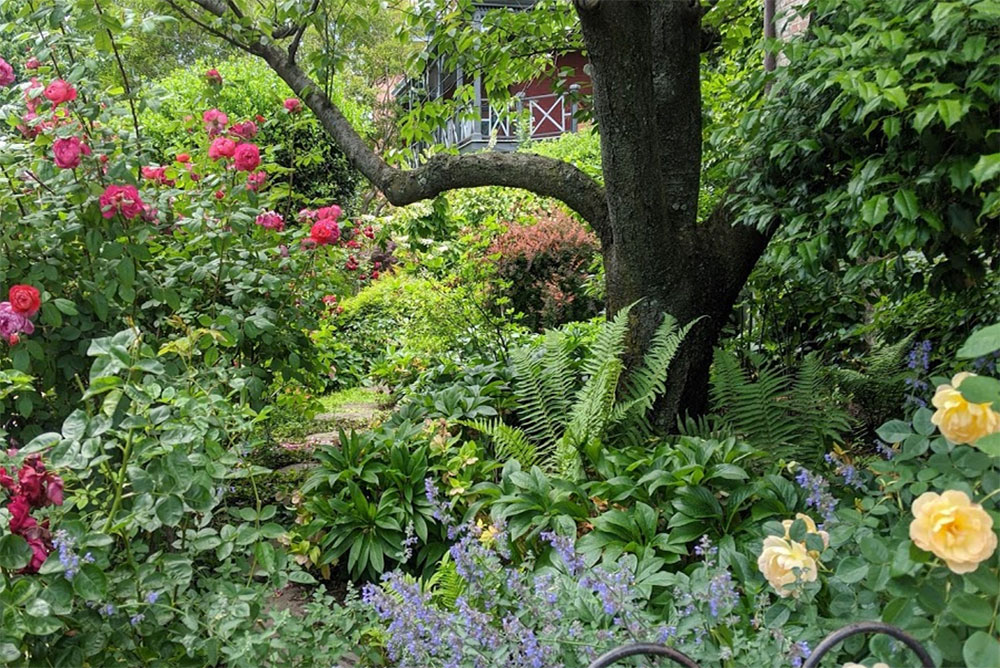
LittleBird Stephanie won a neighborhood prize for this photo of a well-established Capitol Hill garden that features waves and waves of roses that follow a meandering path, intermingled with greenery and other blossoms. / Photo by Stephanie Cavanaugh.
By Stephanie Cavanaugh
THE LAST TIME I won a prize, it was as the Best Queen Esther at our shul’s* annual Purim party, a festival when kids dress up as various Biblical characters, eat cookies and shake noisemakers. That was, I think, in 1958. I wore an evening gown of my mother’s, orange lace it was and probably dragging all over the floor. Since I can’t think this was an attractive look, I can only imagine my competition.
So, I am pleased to say I just won third prize in the Capitol Hill Restoration Society’s annual photo contest, which more or less coincides with the organization’s spring House and Garden Tour. While it’s a swell shot, it’s possible that I was the only garden entry. I suspect this because the other winners and all the honorable mentions (except one other garden, which also happened to be mine) were artfully composed photos of rooflines and brickwork, railings and windows. The stuff of historic homes, which is what the association is all about.
So, my gardens were picked to represent, shall we say.
My prize shot was of the garden that first captivated me when we moved to The Hill 38 years ago. It runs along the side of the corner house on what’s known as Philadelphia Row, eight or 10 tall brick Victorian-era houses so named because they look to belong in the City of Brotherly Love, not our Capital of Chronic Kvetching.
That end unit has a pair of long porches with Chippendale railings running along the side, rooms opening onto it in breezy Southern style. The garden stretches from the house front all the way back past the carriage house, probably 150 feet, and every inch of it is densely planted, mainly with roses. There are ramblers and climbers and shrubs, tea roses and floribundas. Pinks and reds and oranges. They blossom from early spring through fall, and they’re dream-scented: none of that pretty-to-look-at-but-sad-to-sniff stuff here.
Most delightfully, they are mixed with ferns and shrubs, small trees and a sprinkling of companion flowers like blue salvia.
A flagstone path meanders through, letting the gardener more safely prune and pick amid the barbs; it appears casually laid, as if the stones simply happened.
Too often, in my sensitive opinion, roses are treated as rarefied specimens, each allocated a neatly mulched space, nothing abutting the precious petals. When they go out of bloom, they sit there all nasty with their thorns out—there’s not much pretty about rose leaves. Mixing them with other plants and flowers allows them a showcase when in bloom, a backdrop of greenery— and obscures their less tasty aspects when they’re not.
Sadly, the home’s most wonderful rose of all went belly up years ago. A yellow climber, it rose 30 feet in height and about as wide to completely cover a blank side wall. To call it astonishing is an understatement. Of course, I coveted it.
Being directionally challenged then as now, I stood there for far too long figuring out its exact location so I could attempt to replicate it in my own new little patch.

LittleBird Stephanie’s garage, which looks like a charming cottage thanks to the arched door. And yes, you’ve seen this image before. / Photo by Stephanie Cavanaugh.
At the end of our garden is the garage, which, I’ve already shown you too many times, looks like a charming cottage thanks to a pair of tall windows that flank a beautiful old turquoise-painted door. In the right corner we planted a wisteria, in the left a Queen Elizabeth, a dazzling, sweetly scented pink climber. The concept was that the rose would climb and tangle overhead with the wisteria blossoms in a fantasia of scent and color.
It was half a triumph, as the rose was glorious for years, dancing along the wall between our garden and the neighbors’, bearing clusters of flowers for several spring months. But the wisteria, which has more than lived up to its reputation as invasive, running rampant every which-where in the garden, has tossed off but a handful of flowers over the years, possibly the only wisteria in existence that blossoms so poorly.
The rose eventually died in the shade of the apricot tree that was a twig when we moved in but quickly grew to monstrous size and repugnant disposition. When it died, it was replaced by a Kwanzan cherry, another ill-considered monster but with a milder temperament.
And so we have a shade garden, which I am resigned to, as well as being resigned to admiring and smelling the roses in other people’s patches. On the upside, it does save on fertilizer and fuss.
*Shul. Yiddish for synagogue

If ever someone perfectly fulfilled the role of a “photo-journalist” it is you – Stephanie Cavanaugh a wizard with a pen and a camera!